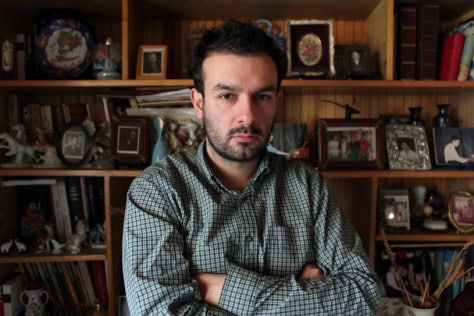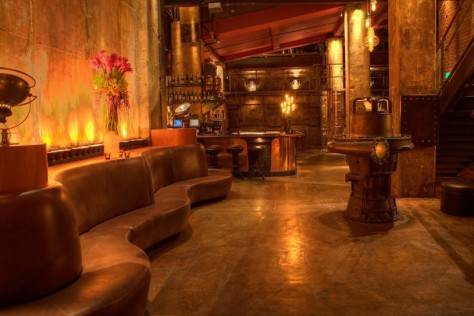Minneapolis-based graphic design studio, Aesthetic Apparatus has long been hailed for its unique concert posters. (You've seen dozens before—flip through the samples in the media player to the right, and be surprised to find that you recognize them all!)
The company was founded by Dan Ibarra & Michael Byzewski sometime around 1999 (about a year after they'd met while both working at Planet Propaganda in Madison, Wisconsin). Over the decade or so that the two have collaborated, they've produced countless posters for esteemed and small-time bands alike, branded a handful of companies, created tons of T-shirts, developed many packages (particularly for DVD's), and done just about everything else a successful studio hopes to achieve at some point in its life.
We interviewed Ibarra for the lowdown on the company's history, it's current standing, and it's future.
Aesthetic Apparatus has gone through several phases. What're you doing now and how does it differ from your poster-centric work of the past?
At this point in the development of Aesthetic Apparatus we're paying a lot more attention to girls and hair has begun to grow where it didn't before. It's an exciting time in our life. Aesthetic Apparatus will always in some way be poster-centric as the process and the printmaking and the community really is still our most exciting part of the studio. But the way that definition has expanded will always be up in the air.
We've never really planned anything in regard to what we're going to do next. We've successfully cobbled together some definition of a “style” that has made for a pretty easy transition into illustration, which we've been getting a lot of work doing lately. Whether that's because we may be good illustrators or just simply because our new website now has an “illustration” section and potential clients have thought to themselves “let's give them a shot” is yet to be determined.
We don't ever really worry about the when and ifs if we want to start making books or movies or stage plays or a line of signature edition eye wear for walruses. We'll just do it.
Your work is simple and elegant yet bold and energetic. How do you approach a “gig”? If a band requests a poster, for example, do you apply some sort of prescribed template or do you try to visually respond to the artist's music and aesthetic?
We approach a poster just like we would approach any job. We consider the band: who are they; what are they saying; what are they feeling; what are they trying to do? We consider the audience: why do they like the band; what have they seen before for or from this band? Then we consider new fans: what do you need to do to successfully communicate what the music feels like to someone who has never heard it before? Then we throw all that direction away, put an animal with crosses over it's eyes (horned or tentacled animals are a plus) or a big head on the page, place the corresponding skeleton or skull underneath, put some like, words on it somewhere really small or really big (depending on size of head) and congratulate ourselves with a cold one and a new beanie baby.
On that note, how exactly do you get jobs? You've done so many posters; do you think you're an established name or do you have to continue selling your brand and vision?
It's a weird mix. Historically, a poster artist who works with a wide variety of bands is usually doing so through a promoter or club, as that has always been the promoters responsibility, to promote the show. Working with local clubs and then getting connections and approval from the band via these clubs is how we've done a lot of posters in the past and how we still do it from time to time. Although, now it's reached that point where there are way too many people out doing posters and the poster has become such a prominent form of alternative merchandise that it's much more difficult to create a poster through that traditional process.
Recently, bands and management have realized the idea of the poster-as- merchandise and they have begun to directly commission series, singular artists-of-hire, or simply started making posters themselves in order to fulfill the fan's desire for posters. It's become much more about relationships— aesthetically and emotionally—between bands and poster artists… which is exciting and confusing at the same time. How this economy will work in five years (if it's still there) is still up in air.
There's a common thread woven throughout every one of your pieces. You generally use a select few fonts, washes, brushes, etc. What is it that has drawn you to this style? Who do you look up to for inspiration?
Style is weird. It's like having an accent. You can sense it but we're not thinking consciously about it. You hang around a lot of people or stuff and it just becomes you.
We've always loved ephemeral, mid-century design, color, printing and typography, but at this point we've rifled through so many Industrial Farm supply catalogs, children's books, and LIFE magazine's, and have been so heavily influenced by them in the past that we're never consciously thinking about style or image anymore; we're just making what looks right to us. That goes for typography, composition, color, whatever.
It's interesting how you sell posters, art prints, and test prints. What distinguishes the three types of art and how do they all come together for your final, publicly-seen pieces?
It's really been an organic progression. We started off trying to sell posters online and that went really well. Then when we moved up to the Twin Cities we had this pile of test prints that we thought were really beautiful so we made up a price and threw them online and those also went really well.
Once established in the Twin Cities we got asked to do a few gallery shows and those went well, too. After a while we decided to put some “non-poster” art in the shows along with posters and test prints. And that's gone well. The Doomdrips™ stuff that we've been making has been well-received. Basically, the plan is to not have a plan. Whatever we want to do next we do next. We figure if we stay small, we can keep with this “plan” until we run out of money or people stop caring, whichever comes first.
You also have been working on branding, packaging design, and non-poster work in general. How do you approach these jobs? Are such projects similar to your promotional-geared works?
We both started as designers at a great studio in Madison called Planet Propaganda. So we know how to roll out an extensive promotional campaign or design a large catalog or a series of ads or an identity system or whatever—that's our foundation. As we mentioned earlier, we kind of approach everything all [in] the same way—the way we feel a designer “should.” Goals might not be as spelled out or as strict as they might have been in our previous employment, and we might get our share of (deceptively dreamy but realistically painful) “do anything you want, just make it cool” project briefs, but in the end we're still trying to be critical and smart about the whole thing while still never feeling like we're not having fun.
You'd have to try quite hard to run a 3-person studio and not have fun.
Aesthetic Apparatus also utilizes a striking color palette. How does color figure into the equation when you're working on a client's poster, cover, etc.?
Our overuse of baby blue is a constant joke at the studio but we do realize that we like bright colors. That's just our accent I guess. It's never conscious. It's just what we want to look at. We just like the way bright colors make our eyes feel. Seeing a line up of bright-blue and red posters buzzing away on a drying rack is always exciting to see. We're just not really dark and gloomy people. Or, the doom and gloom lives in our blue.
You don't openly have a bias towards any media, art form, or variety of creative voice, but I'm curious to know what you privately enjoy and admire. What authors do you like? What directors do you appreciate? What bands do you rock out to?
I don't think we're going to blow anyone's mind with what our non-design inspirations. Dan and his wife Kelly are now watching the entire Deadwood series for the third time. And Dan finds himself laughing out loud by himself when reading Johnny Ryan. Michael is stealing ideas from his four-year-old son and one-year-old daughter which may explain the Doombuddy series. Dialogue from Patton Oswalt and Hulk Hogan albums (yes, the hulkster cut a record) are often quoted at the studio along with lines from Coen Brothers movies. And we all agree that Fred Rogers' U.S. Senate testimony is probably one of the most inspiring moments ever captured on film.
 Q&A with Larry Gus
Q&A with Larry Gus We Own the Night: The Edison
We Own the Night: The Edison
1 Comment
Hi! I understand this is kind of off-topic but I had to ask.
Does building a well-established blog like yours take
a lot of work? I’m completely new to writing a blog however I
do write in my journal everyday. I’d like to start a blog so I can easily share my experience and feelings online.
Please let me know if you have any kind of recommendations or tips for brand new
aspiring blog owners. Thankyou!
Look into my blog post; chaplin js